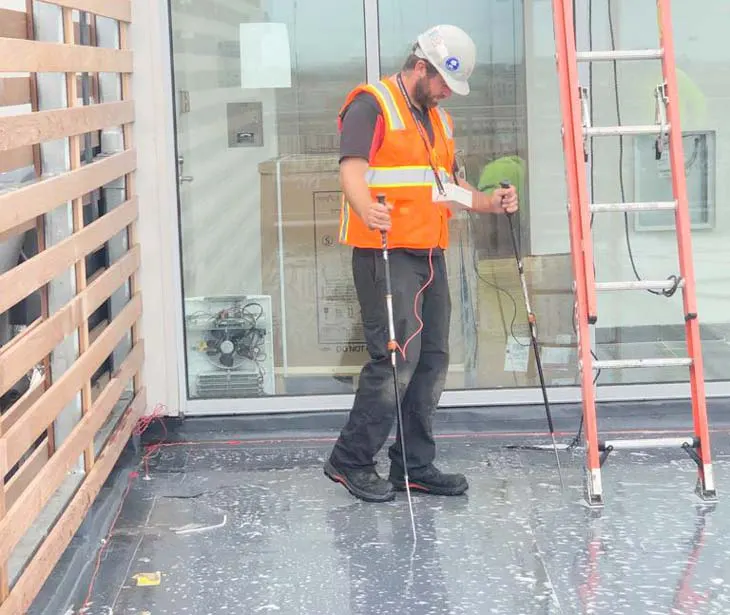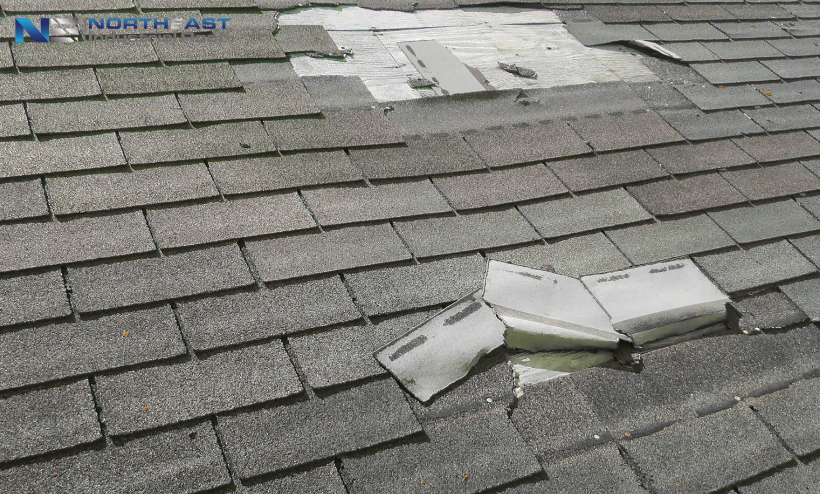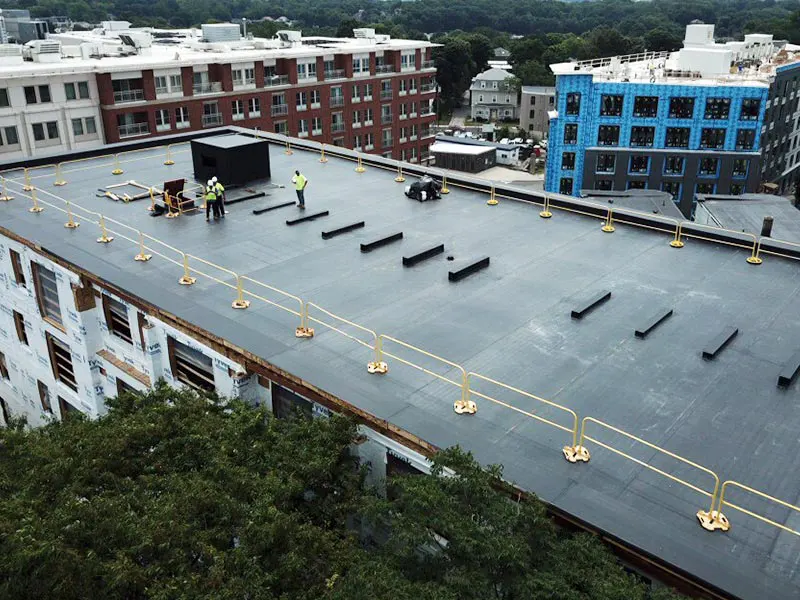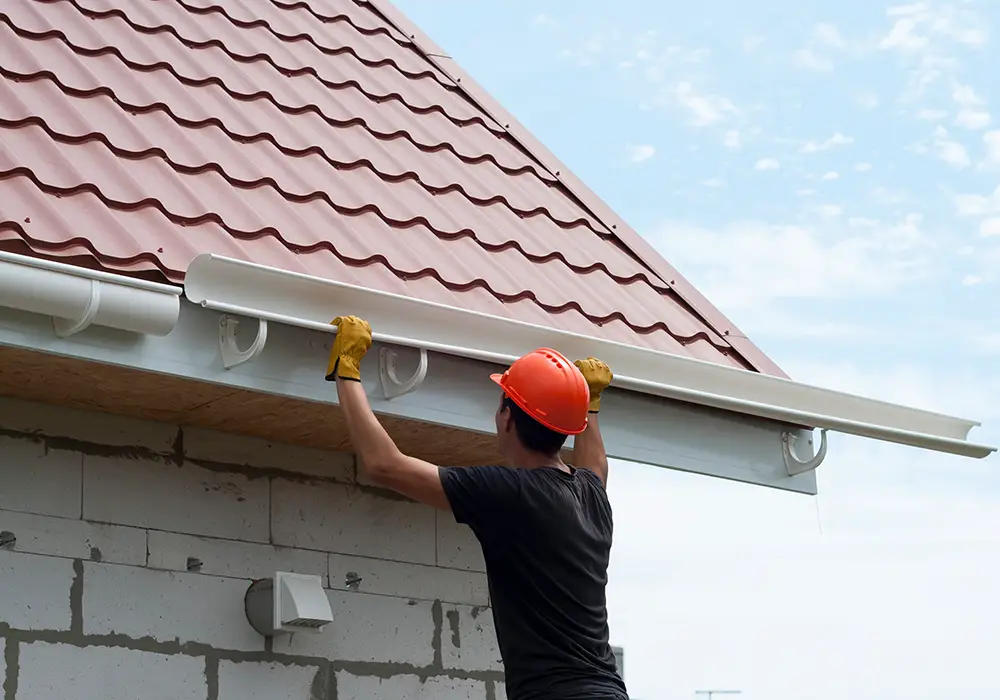Commercial Roofs: Leak & Moisture Detection
October 28th, 202
Most commercial buildings have flat roofs that are outfitted with waterproofing membranes to protect the structure underneath from moisture. For building owners, it’s easy for roofing to become “out of sight, out of mind,” especially with so many other day-to-day business activities usurping all of their attention. Roofing membranes, however, are a crucial part of a building’s roof. Though it’s rarely seen, as it’s often covered over by other roofing materials such as landscaping, metal roofing panels, pavers and more, it’s the most critical element in a roofing system.
When a roof’s waterproofing layer fails, it can be extremely costly to expose and repair. In some cases, the entire roof must be replaced. To avoid the prohibitively expensive process of identifying, excavating and repairing a penetration in the membrane, integrity testing is often required before installing additional roofing materials, and even if not required, many roofers choose to perform this testing to avoid issues with post-install moisture intrusion.

Types of Integrity Testing
Integrity Testing
- Spray testing
- Low voltage testing
- High voltage testing
- Flood testing
Moisture Detection
- Nuclear metering
- Infrared thermal imaging
- Capacitance testing
Spray Testing
Spray testing mimics normal and severe weather conditions by introducing a controlled flow of water to the membrane and flashings. This test is typically performed on low-slope roofs and utilizes an array of nozzles that allow for varied water pressures at specific distances to allow the interior and exterior of the building to be inspected for a leak.
Spray testing is useful when other methods of testing are made difficult or impossible due to the configuration of the roof or other access limitations. Spray testing is also more practical than electrical testing when there are multiple breaches present, and the speed and ease at which results can be gleaned make this test viable for even less-experienced operators.
The main disadvantage to spray testing is the chance that activating the leak could incur further damage to the structure. Other limitations include the potential for particularly lengthy amounts of time for the leak to reach a visible point and the possibility of not being able to replicate the exact conditions required to detect the leak.
Low Voltage Testing
- EPDM, modified bitumen and any other conductive membranes cannot be tested using this method.
- If the breach is too new to have been thoroughly penetrated by moisture, the circuit won’t close and the breach could go undetected.
- If the breach is buried under layers of insulation or dirt, the meter may not detect it or the signal can be too faint for the technician to interpret.
- If there are more than one or two breaches close together, it can be difficult to isolate the individual breaches.
High Voltage Testing
This test uses an electrically-charged metal “broom” to sweep over the grounded surface of the membrane and indicates the points at which the current closes (the breach). High voltage testing can also detect spots in the membrane that don’t meet minimum thickness requirements. This method is often preferred over low-voltage testing due to the lack of water required for the test. However, the need for the membrane to be dry before performing the test can present delays. Other limitations of this test include:
- The membrane must be exposed, meaning that the test cannot be performed through other materials on the roof.
- Technicians who perform this test must be experienced, as false positives are often presented.
- Liquid-applied membranes can suffer burns from the broom if the membrane was applied too thinly.
- Electrically conductive membranes (like black EPDM and foiled modified bitumen) cannot be tested using this method.
Flood Testing
As the name suggests, flood testing is typically conducted by flooding a waterproofed roofing surface with two or more inches of water and leaving it for up to 48 hours. While this test is basic and usually quite effective, it’s important that the person or team performing the test understands the safe carrying load of the structure before carrying out the test.
The roof’s drainage is temporarily sealed off and in some cases, temporary dams are erected to segregate the area being tested. A flood test requires access to the underside of the flooded areas for the purpose of performing a visual inspection of water leakage.
For obvious reasons, this test cannot be performed on vertical surfaces, and for areas with a slope of greater than ¼” per foot, the depth required will be much greater, putting much more added weight onto the building’s structure. Once the testing is complete, the water must be safely drained, which, done improperly, can cause damage to the building’s plumbing system.
Nuclear Meter Testing
This method is also interpretive, providing relative readings that the technician has to decipher to determine moisture content. The test works by emitting a stream of neutrons, which collide with hydrogen atoms and bounce back to the meter. When the neutrons return to the meter, the speed at which they’ve done so is recorded and a digital readout is provided to indicate the possible moisture content at each spot on the roof’s grid. The areas of suspected moisture content are then inspected visually to determine whether there is a leak and where exactly it originates.
Nuclear meter testing can be carried out during the daytime hours, allowing for immediate visual inspection and location of a leak. The main limitation of this method is that it requires the transport of radioactive materials, which are subject to strict regulation.
Infrared Thermal Imaging
IR testing is an interpretive testing method of detecting moisture that relies on the difference in temperature between wet and dry building components. This test is typically performed using a handheld IR camera and peripheral recording equipment for the purpose of collecting the information for future viewing. This testing method has its own set of limitations, including:
- The test is most accurate when performed in the evening after a sunny day to create the right temperature differential for the IR camera.
- Homogenous materials can hold the same amount of heat, leading the tester to assume that elevated temperatures within these materials are due to the presence of moisture.
Capacitance Testing
This test uses an electric field over the membrane, measuring the moisture content of the membrane assembly by using a sensor to read the strength of the electric current when passed over it. The test can be customized based on the substrate material, increasing or decreasing the strength of the electric field and the sensitivity of the sensor as needed. These customizations provide a higher level of accuracy than other testing methods, but the results are dependent on the interpretation by the technician operating the equipment.
This test only serves to detect moisture and does not necessarily indicate the presence of a breach. For this reason, further testing may be necessary to identify and locate the suspected leak. Further limitations include the length of time required for laboratory testing on the core samples to be concluded, the fact that the presence of moisture does not necessarily mean there’s a leak, and the necessity for the membrane to be completely dry and completely uniform before performing the testing.
Conclusion
Different scenarios require different testing methods, so ultimately there is no “best” method. The unique conditions of each project are evaluated to determine which method will produce the most accurate results. This will obviously vary depending on the type of project, the technician’s expertise and experience and the roofing materials being tested. As Boston’s experts in commercial roofing, Northeast Industrial Roof is the only call you need to place when you suspect your commercial roof has suffered damage resulting in a leak.






